- Home
- Sequencing Batch Reactors
Sequencing Batch Reactors
About
STP
Sequencing Batch Reactors
Sequencing Batch Reactors (SBRs) are a type of wastewater treatment technology that operates in a batch mode. The treatment process occurs in a single tank where wastewater undergoes sequential phases including filling, aeration, settling, decanting, and idle/resting periods. In an SBR system, the wastewater is first introduced into the reactor tank during the filling phase. Once filled, aeration begins where air or oxygen is supplied to facilitate biological treatment. The microorganisms present in the tank utilize the oxygen and break down organic matter in the wastewater.

Process of Sequencing Batch Reactors (SBR) :
- Fill the reactor tank with wastewater.
- Aerate the wastewater to promote biological treatment.
- Allow the wastewater to react and biodegrade organic matter.
- Settle the solids and biomass at the bottom of the tank.
- Decant or remove the clarified effluent from the top of the tank.
- Repeat the cycle for subsequent batches.
- Optionally, treat and manage the settled sludge for further processing or disposal.
Benefits of Sequencing Batch Reactors (SBR) :
- Versatile and effective for treating various wastewater types.
- Efficient nutrient removal capabilities.
- Flexibility in operation and control.
- Compact footprint and space-saving design.
- Enhanced removal of organic matter and contaminants.
- Reduced energy consumption compared to continuous flow systems.
- Ability to handle variations in flow and load.
- Potential for integration with advanced treatment processes.
- Compliance with stringent regulatory standards.
- Suitable for retrofitting existing treatment plants.
Some Technologies of Sequencing Batch Reactors (SBR) Are :
Aeration Systems: Supply air or oxygen for microbial activity.
Mixing Devices: Ensure proper mixing of wastewater and activated sludge.
Settling Mechanisms: Facilitate separation of solids and biomass from effluent.
Decanting Systems: Carefully remove clarified effluent without disturbing settled sludge.
Process Control Systems: Monitor and regulate key parameters for optimal performance.
Sludge Handling and Treatment: Recirculation, wasting, dewatering, or digestion of settled biomas
